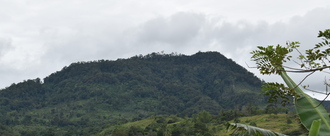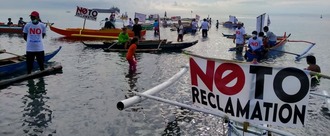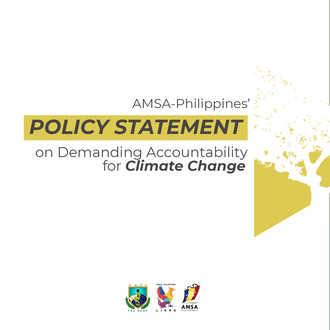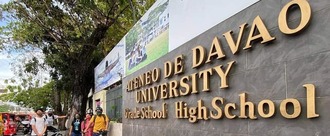-
Dear Presidential Candidate: Senator Ping LacsonCurrent and dominant election narratives in the news and in social media focus on personalities and partisanship. We believe that this focus must be shifted and more space must be made for tackling issues, particularly the issues that will define the future of the planet and the fate of the youth. The #Love52 movement envisions an empowered and forceful youth voice that is demanding good governance and a better normal. “Why do we vote?” We vote to protect our loved ones, our country, and our planet. Together with various youth nationwide, we’ll seed changes in the Filipinos’ thinking about election issues, and show them that they have the power to change the narrative and move candidates to adopt the youth agenda.10 of 100 SignaturesCreated by Love, 52

-
Dear Presidential Candidate: Mr. Norberto GonzalesCurrent and dominant election narratives in the news and in social media focus on personalities and partisanship. We believe that this focus must be shifted and more space must be made for tackling issues, particularly the issues that will define the future of the planet and the fate of the youth. The #Love52 movement envisions an empowered and forceful youth voice that is demanding good governance and a better normal. “Why do we vote?” We vote to protect our loved ones, our country, and our planet. Together with various youth nationwide, we’ll seed changes in the Filipinos’ thinking about election issues, and show them that they have the power to change the narrative and move candidates to adopt the youth agenda.7 of 100 SignaturesCreated by Love, 52

-
Dear Presidential Candidate: Mayor Isko MorenoCurrent and dominant election narratives in the news and in social media focus on personalities and partisanship. We believe that this focus must be shifted and more space must be made for tackling issues, particularly the issues that will define the future of the planet and the fate of the youth. The #Love52 movement envisions an empowered and forceful youth voice that is demanding good governance and a better normal. “Why do we vote?” We vote to protect our loved ones, our country, and our planet. Together with various youth nationwide, we’ll seed changes in the Filipinos’ thinking about election issues, and show them that they have the power to change the narrative and move candidates to adopt the youth agenda.12 of 100 SignaturesCreated by Love, 52

-
Dear Presidential Candidate: Mr. Leody de GuzmanCurrent and dominant election narratives in the news and in social media focus on personalities and partisanship. We believe that this focus must be shifted and more space must be made for tackling issues, particularly the issues that will define the future of the planet and the fate of the youth. The #Love52 movement envisions an empowered and forceful youth voice that is demanding good governance and a better normal. “Why do we vote?” We vote to protect our loved ones, our country, and our planet. Together with various youth nationwide, we’ll seed changes in the Filipinos’ thinking about election issues, and show them that they have the power to change the narrative and move candidates to adopt the youth agenda.11 of 100 SignaturesCreated by Love, 52

-
Dear Presidential Candidate: Mr. Ernesto AbellaCurrent and dominant election narratives in the news and in social media focus on personalities and partisanship. We believe that this focus must be shifted and more space must be made for tackling issues, particularly the issues that will define the future of the planet and the fate of the youth. The #Love52 movement envisions an empowered and forceful youth voice that is demanding good governance and a better normal. “Why do we vote?” We vote to protect our loved ones, our country, and our planet. Together with various youth nationwide, we’ll seed changes in the Filipinos’ thinking about election issues, and show them that they have the power to change the narrative and move candidates to adopt the youth agenda.6 of 100 SignaturesCreated by Love, 52

-
Save Makabol Forest and Watershed in Brgy. Salaysay, Davao CityMakabol Forest and Watershed has sustained hundreds of residents for several decades already. It is also a habitat of thousands of Flora and Fauna which includes the critically endangered Philippine Eagle and other avifauna, mammals, reptiles, amphibians, invertebrates, sapling vegetation which relies on emergent dipterocarp trees and many many more. This forest is a metaphor of life and Davao City has renowned banner "Life is Here", so let it be sustained by protecting this forest and watershed. Additionally, Davao City has comprehensive watershed management code, which is totally the best if not the only option to protect this forest even if it is privately owned. Please help us with this cause and support the revocation of the logging permit. Please sign the petition and together let us save Makabol Forest and Watershed for our future generation.1,722 of 2,000 SignaturesCreated by Benito Anthony Pingoy
-
Statement of Support to the Opposition Against the Proposed 174 Hectares Dumaguete ReclamationThe proposed project will cause irreversible damage to the marine ecosystem specially that there are four marine protected areas and will directly affect the livelihood and food source of fishing communities in the area who depends on the city's coastal waters for sustenance.414 of 500 SignaturesCreated by Aidalyn Arabe
-
Sagipin ang Ating Nayon!DOT, National Task Force Against Covid, and Enrique Razon of ICTSI want to make use of Nayong Pilipino Foundation urban park in Entertainment City in Parañaque for a proposed Mega Vaccination center. They say it is urgent and that the NPF board needs to sign an agreement as soon as possible. The NPF board is still waiting for detailed plans of the mega vaccination site, as it has raised concerns for the growing ecosystem in the urban park. The NPF board also raises legal concerns about the involvement of a private entity - ICTSI Enrique Razon. What is the need for the NPF urban park and green open space, when there are other existing spaces for inoculation? Since vaccination is urgent, it is more efficient to use existing structures to administer vaccination in Metro Manila. Coliseums, universities, and parking lots are excellent venues for vaccine drives. Contrary to what the DOT and ICTSI have been saying, the NPF land is not a vacant lot but has a thriving green space that hosts a variety of urban wildlife and is the last remaining grassland in the reclaimed area of Parañaque. The site is a bird flyway network and is close to the Las Piñas-Parañaque Critical Habitat and Ecotourism Area or protected wetlands under the Ramsar Convention, to which the Philippines is a signatory. See wildlife of NPF urban park here: http://nayongpilipino.gov.ph/the-birds-of-nayong-pilipino-healing-forest/ The cutting of almost 500 trees and other site works would "kill the existing ecosystem. Once lost, it could take decades to recover this ecosystem. A mega-vaccination facility that will destroy this ecosystem would be a disaster and a disservice to the residents of Metro Manila who need more green and open spaces. Our alliance is seeking transparency on the need for such a development. We also ask for Ground activities not to take place until a MOA between NPF and a government entity has been completed, and not between ICTSI. The MOA must specifically say that it is only a temporary facility that must be removed after the proposed 300 days. The MOA must also state that the ecosystem is considered in the design, and the size should just be proportionate to the needs of the facility. Private Entities Cannot Use Government Land The Nayong Pilipino Creative and Cultural Hub is owned by the Nayong Pilipino Foundation, a Government-Owned and Controlled Corporation under the Department of Tourism. It has its own charter and mandate. There is no official, written agreement between the NPF, DOT, IATF, and any private entity regarding its conversion into a mega-vaccine facility. The legality of this conversion must be reviewed against Presidential Decree No. 1445 the Government Auditing Code of the Philippines so as to ensure that this public property will not be land-grabbed. Even Architect and Urban Planner Felino “Jun” A. Palafox of Palafox Associates, was engaged by ICTSI Foundation to design the proposed mega-vaccination center. Palafox has voiced his reservations on the construction of a Mega-Vaccination facility at the NPF Creative and Cultural Hub because: 1.) The land cannot handle medical waste and 2.) It would require the removal of more than 450 trees onsite. We must save the Nayong Pilipino Creative and Cultural Hub as an urban, green, and open space. This is not about choosing trees over people's lives. People need trees to thrive, not the other way around. Metro Manila needs more green spaces. And if we truly want to end the pandemic, biodiversity matters now more than ever.577 of 600 SignaturesCreated by Alyansa ng Bagong Nayon Natin

-
STOP the cutting of trees along Bacolod Old Airport, Araneta st.Trees are important. They do not grow in an instant, even if we plant hundreds of seedlings we sould not compare the benefits of a full grown tree from seedlings because no one can buy time to grow these trees.109 of 200 SignaturesCreated by Jeffrey Lazaro
-
Demanding Accountability for Climate ChangeIntroduction: In the face of a pandemic, climate change remains to be one of the defining issues of our time. Some of the impacts already evident in the Philippines include decreased water availability, extreme heat, and stronger, more frequent typhoons. The series of typhoons that recently hit the country and the destruction that it left behind verifies the authenticity of climate change. The Philippines is the most vulnerable to climate-related events. Unfortunately, the present pandemic has only managed to further cripple the health sector and expose the discrepancies of the nation’s response. Climate change significantly affects the environment, economy, and healthcare system of the country. It disproportionately affects vulnerable populations (elderly, children, indigenous communities, women, and coastal populations) and low-income and middle-income countries, leaving them victims of climate emergencies and placing the burden of disease on those least responsible. Maintaining vigilance about this issue allows communities to take action on attainable goals and preempt future difficulties that this country has yet to confront. AMSA Philippines’ Position As a national organization that places health at its forefront, the Asian Medical Students’ Association - Philippines believes that it is time to declare a climate emergency follow-up on the climate change framework following the recent declaration of Climate Emergency by the Congress. Climate change is not only bounded by the ruination caused by extreme climate events. The extent of human contribution to its modernization and aggravation should also be scrutinized. In actuality, various repercussions also need to be factored in such as the loss of livelihood, the dramatic increase in mental health problems, and a shortage of basic needs such as food and water. This statement is to address the insufficient measures that the government is implementing to build a more disaster-resilient country and its enforcement in imposing stricter environmental regulations to major climate change contributors in this country. Furthermore, other stakeholders are called to further engage themselves to this aim. Currently, it appears that the national government — which are responsible for implementing policies, mobilizing efforts, and exhibiting strength through its dedication to climate policy and institutional reform agenda on climate change adaptation, mitigation, and disaster risk reduction (CCAM-DRR), does not fully understand the importance of anthropogenic accelerated climate change and how much it gravely impacts us. Climate change goes beyond extreme climate events (ECEs). Climate change, together with processes like urbanization and environmental degradation have impacts on food and nutrition security, agriculture, community-based disaster risk reduction, mental health and so much more. The environment is continuously threatened, primarily by the actions of big corporations that exploit our natural resources. It is imperative that the absence of specific measures to establish resilience to the effects of climate change be addressed and mitigate its causes to overcome the challenges of dealing with the macroprudential deficits, restoring growth, minimizing poverty. A partnership with the private and public sectors is necessary to understand the risk that requires considering not just climate change, but also current and future vulnerability and exposure. According to a report by the World Input-Output Database stated in the Healthcare Climate Footprint 2019, the healthcare sector is one of the industries that contribute to carbon emissions and plastic wastes. Healthcare’s operational emissions produce 4.4% of the total climate footprint. The healthcare sector has a vital role in protecting the health and wellbeing of populations from the impacts of climate change. Leadership, guidance, and regulatory roles from healthcare professionals have great significance with regards to health-determining factors, such as emergency planning, and recuperation in the aftermath. Therefore, as future health professionals, it is our responsibility to understand that the mechanism of the adverse effects of climate change has both direct and indirect impacts on the communities around us. Direct consequences being deaths, injuries, psychological effects, and various diseases. While the indirect consequences of disasters not only refer to the loss of primary health care, living conditions, limited or no access to administration, but also damages to health care systems regarding external infrastructure such as the provision of water and/or electricity. As evidence shows the impact of climate change, there is a need for collaboration between all stakeholders in the country, and all must work together efficiently and synergistically to save lives. We must first start by calling to action the local government units and the national government, and by working with NGOs and academic institutions to refrain from band-aid solutions and shift the climate change response into a multisectoral approach and adapt the health in all policy. This would require all stakeholders to work in a coordinated manner, in a single climate change strategy and coordinating mechanism. Lastly, the curricula of institutions at all levels, particularly in medical education, should include the health effects of climate change such as malnutrition, threats to mental health, increased respiratory and cardiovascular diseases, and infections caused by food, water, and vector-borne diseases.146 of 200 SignaturesCreated by AMSA- Philippines
-
Save Trees, Save LivesA petition that condemns the plan to cut down eight trees, mostly Narra trees, along the sidewalk of Ateneo de Davao University Grade School in Mc Arthur Highway to give way for a layby or road widening. With the current situation of our city where our Urban Heat Index is increasing, it is of utmost importance to have trees in the roads or parks to allow walkability and decrease heat and pollution in the city.152 of 200 SignaturesCreated by Interfacing Development Interventions for Sustainability Inc.

-
Reform Our DRRM Strategy and Pursue Climate Justice NowThree typhoons hit the Philippines in less than one month. Typhoons Quinta, Rolly, and Ulysees battered Luzon, damaging homes and livelihoods and forcing thousands of families to leave their homes. Like with past disasters and the ongoing COVID-19 pandemic, these storms revealed deep structural gaps in our country’s disaster risk reduction and management (DRRM) and climate adaptation. In each of these storms, disempowered local government units had to stretch their already insufficient resources because of delays in the response of the national government, which was once again caught flat-footed. At a time where the country faces ever-worsening threats, the current administration slashed the appropriation for the National Disaster Risk Reduction and Management Fund. Even more damning is the lack of a coherent national strategy for mitigation, preparedness, and response. We believe no amount of spending can make up for an uncoordinated and ad-hoc approach. This is why we are demanding that the government develop a national strategy focusing on three areas: prioritization of DRRM and climate adaptation; coordination and collaboration with stakeholders at the national and local levels; and pursuit of Climate Justice. Over the years, survivors have learned recovery, perseverance, and the pursuit for justice. Meanwhile, governments and corporations responsible for environmental disasters have remained unflinching in their non-action. The lack of policy implementation, long-term solutions, and radical change is glaring proof of the negligence of governments and exploitative industries, as they continue to profit off of environmental destruction that are causing these climate-related disasters. We refuse to reduce resilience to a front-page photo of a person smiling amid floodwaters. Local and national governments must face responsibilities beyond immediate relief response. True resilience in climate-impacted communities should mean weather-proof infrastructure, independent energy systems, and development centered on sustainability.74 of 100 SignaturesCreated by We The Future Philippines













